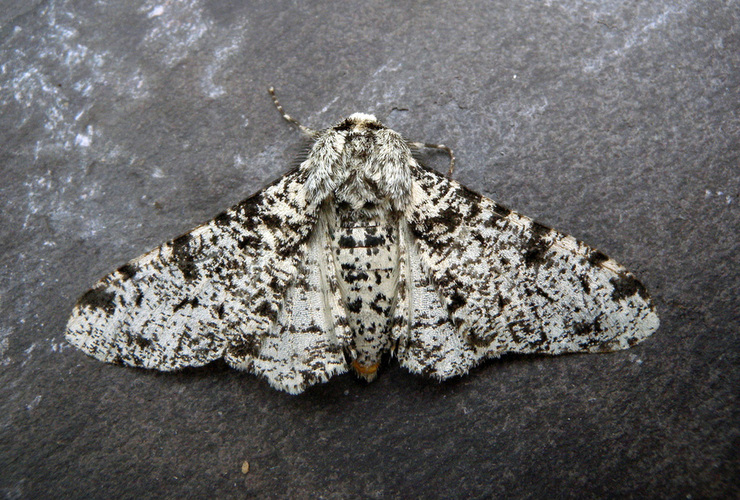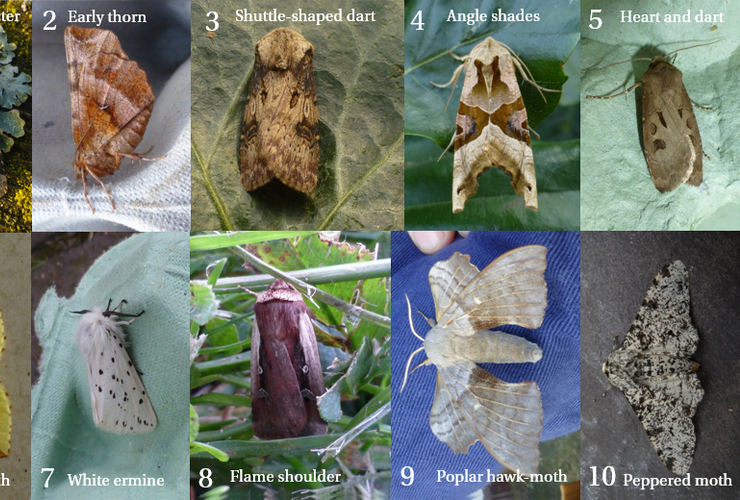Field Notes: A beginner’s guide to moths
Tom Hayek, our England and Wales Development Manager, shares his top tips to get you catching and identifying moths

Start catching individual moths by using an empty jam jar* as they rest on the outside of your window at night - just leave your curtains open. You can then take your time to work through books or websites to find out what you’ve got.
Some moths can be easily disturbed from grass or bushes during the day, so it’s worth spending time in the garden, or local public green space, taking photos. This will give you manageable small numbers of specimens to identify at any one time.
*If you want to progress beyond using jam jars, then you can buy glass or plastic specimen pots/tubes which will be easier to photograph through and less cumbersome.
10 moths to spot in May

1. Hebrew character: look for the dark curved mark in the middle of the wing said to look like a saddle.
2. Early thorn: they sit with their wings upright like a butterfly and you can see the white or silver ‘v’ on the underside of the hindwing.
3. Shuttle-shaped dart: look for the stretched oval shape with a dark centre in the middle of the wing. This is said to look like the shuttles that used to be used for weaving threads on a loom.
4. Angle shades: with the more pointy ends to the wings, these are unmistakeable. When they’ve just emerged from their chrysalis, the pink and green markings can be really bright.
5. Heart and dart: one of the most common moths in the UK, they are named after the long dark streak near the top of the wing (the dart) and the dark heart shape near the bottom of the wing.
6. Brimstone moth: sharing a name with the brimstone butterfly, this moth is also bright yellow and has black or brown markings.
7. White ermine: this moth is bright white with lots of black spots and holds it wings in a ‘tent’ shape.
8. Flame shoulder: this moth has a cream stripe down the side of each wing and two different-sized white marks on the inside of those stripes.
9. Poplar hawk-moth: this is the first of the hawk-moths to emerge during the year. They are a grey/silvery colour and their wings are shaped a bit like leaves with the hindwings sticking out above the forewings.
10. Peppered moth: this moth holds its wings stretched out and its name comes from the peppery grey and black speckles.
Help to identify your moths
Books
The go-to is the Field Guide to the Moths of Great Britain and Ireland by Paul Waring and Martin Townsend. If you find you’re enjoying moths, Chris Manley’s British Moths will enable you to compare drawings and photos.
Online
There is plenty of help available online, but if you have a go at identifying any photos of moths you post on social media, people will be more inclined to help and give feedback on what to look out for if you haven’t got it right first time.
- On Facebook join a group to help you identify what you have in your photos. The one I find most helpful is Moths UK & EUROPE. It’s worth checking whether there is local one for your area too.
- On Twitter add #teammoth to your photo to hopefully get some feedback on what you’ve found.
- On the internet start with UK Moths and check out the county-based ones (e.g. Yorkshire Moths). A great additional resource is the ‘what’s flying tonight’ page run by CEH. Add your location and it will show what moths have previously been recorded there, on that date, in order of frequency - significantly narrowing your search!
Build or buy a moth trap
I built my first trap using the guide kindly provided for free by Anglian Lepidopterist Supplies (see pages 6-8). The leaflet also includes a guide to how to release your moths safely (page 3) and sugaring (pages 9-10). This is another great way to attract moths; especially in the autumn when natural nectar sources decrease.
If you would rather buy a trap, there are compact traps available. These run off mains electricity, so bear in mind lines of sight to your neighbours’ bedroom windows – they can be quite bright!
Read how Tom first got into moths in The moth catcher.
Photography: Peppered moth at the top of the page by Mike Shurmer, all other moths by Tom Hayek

